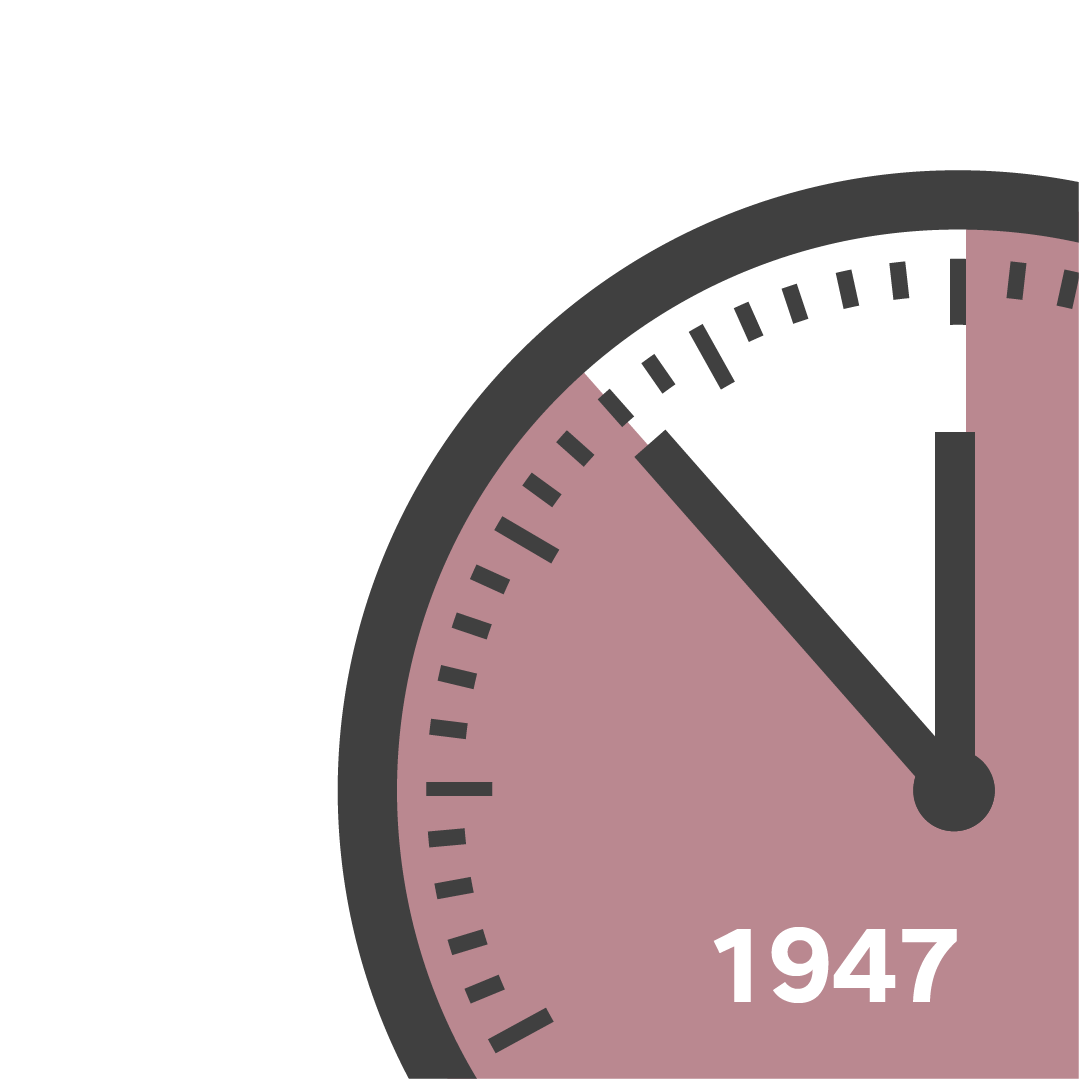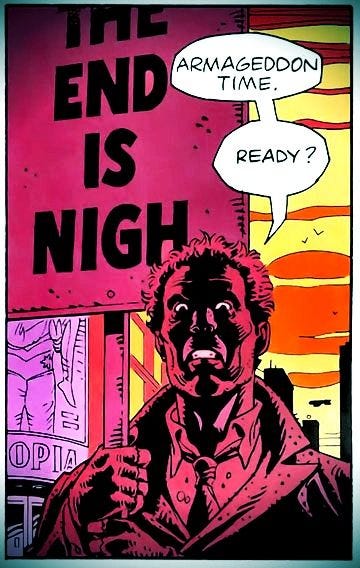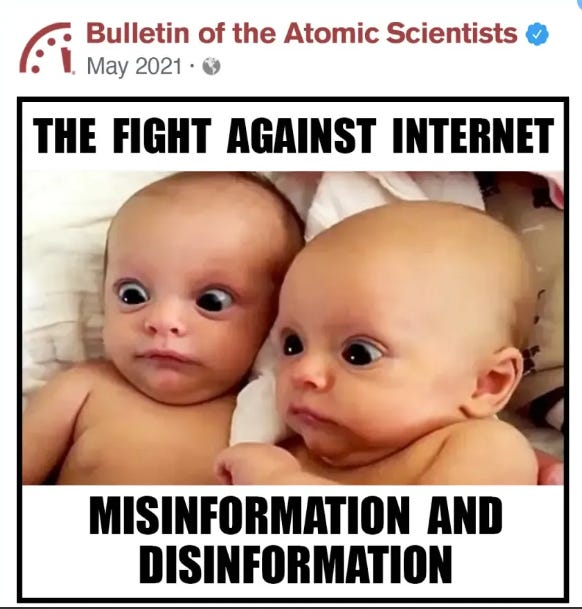Doom around the Clock
The Doomsday Clock is a powerful symbol with great cultural resonance. Let's take a look at its history, some of the issues it faced, and how it came to be set at 90 seconds to midnight.
Did you know that the Bulletin of Atomic Scientists has a Doomsday Clock playlist on Spotify? It’s pretty good.
The playlist contains songs that mention the Doomsday Clock, and it’s a work in progress — they are open to suggestions. A good example of how the clock metaphor is culturally resonant.
Music is by far the main venue to express anxiety as the minute hand gets closer to midnight, understood to be the moment when we shuffle off this mortal coil. One notable exception is the graphic novel Watchmen, a masterpiece by Alan Moore and Dave Gibbons, which helped revolutionize that art form in the 80s.
You can see references to the cultural impact of the Doomsday Clock on the Bulletin’s website.
Design for life
The clock appeared for the first time on the cover of the Bulletin’s June 1947 magazine (it was previously published as a newsletter). Designer Martyl Langsdorf wanted to convey in a simple but compelling way the urgent need for arms control — or, ideally, getting rid of nuclear weapons for good. A desire she shared with her husband, the physicist Alexander Langsdorf, one of the many scientists who regretted taking part in the Manhattan Project, where the first nuclear weapons were developed.
Mission accomplished: the elegant, minimalist design immediately made clear what was at stake. It was Martyl who set the clock to 7 minutes to midnight, based on her designer’s sensibility. “It suited my eye”, she would say later.
The design would change in 2007, marking the clock’s 60th anniversary. Designer Mark Bierut respected the original motivation.
Rollercoaster
It was only in 2015 that the clock started being set every year. After 1947, it was set to 3 minutes to midnight in 1949 (first test of a Soviet nuclear bomb), and 2 minutes in 1953, after the US and the USSR tested their first thermonuclear weapons (the H-bombs). It was the closest to midnight until 2018.
The hand of the Doomsday Clock (as it came to be named in 1972) went back and forth throughout the decades. It was set to 3 minutes to midnight in 1984, the closest since 1953 (it was indeed a very dangerous time). In 1991, with the end of the Cold War, it jumped back to 17 minutes to midnight, the furthest it has ever been.
But from the Bulletin’s perspective things are getting steadily worse since 2015. The clock stuck at 100 seconds to midnight since 2020, and it’s now at just 90 seconds — the closest ever to our demise.

99 problems and the nuke’s just one
It’s true that the war in Ukraine has been escalating in such a way that we may be almost obliviously running towards a nuclear war. But why have we been at 100 seconds to midnight since 2020?
The problem, for many critics, is that since 2007, when the Bulletin decided to add climate change as a further consideration to be taken, the number of existential threats became increasingly bloated. Today we also have the risks posed by “disruptive technologies” (AI gone rogue, biotech, cyber surveillance/security/war), biosecurity issues (bioweapons, pandemics, epidemics), and, most questionably, the putative consequences of “disinformation” and “fake news”.
Come to think of it, it will be hard to set the clock to much further from midnight than where it is now.
And then there’s the elephant in the room.
Cuba: el elefante en la habitación
The Cuban Missile Crisis was the closest the world got to an all-out nuclear conflict between the United States and the the Soviet Union. But the Atomic Clock (as it was called at the time) was nowhere to be found.
This is such a common criticism that the scientists felt obliged to explain why.
“They [the hands] were not moved during the 10-day crisis because too little was known at the time about the circumstances of the standoff or what the outcome would be.”
They go on to say that in the crisis’s aftermath the two governments established a direct telephone line and later signed the first nuclear weapons treaty, banning underground tests. The clock was at 7 minutes to midnight since 1960 (the last time it was set) and the agreement between the superpowers led the Bulletin’s editor, Eugene Rabinowitch, to move the clock’s hand to 12 minutes to midnight in 1963.
Fine — but not convincing.
Everybody was aware of the risks. You just had to read the newspapers, watch TV, or listen to the radio. President John F. Kennedy addressed the nation to warn his country and the world of what was, in his own words, a “clear and present danger”. It wasn’t hard to figure out what was the danger in question.
A metaphor not a measure
But let’s cut the scientists some slack. The clock was not generally known or used as a symbol of global risk at that time. It did not become widely recognized until many years later — especially since the early 80s.
It should also be noted that it was Eugene Rabinowitch alone who set the time until his death in 1973. Thereafter a team of scientists became responsible for a broad assessment of factors in order to adjust the clock. But the clock is not, and never was, intended to be a precise measure or forecasting of global risk. It’s a metaphor for how close we might be to causing the end of the world.
At the end of the day, the process is subjective, reflecting the views and opinions of the Bulletin's experts and their assessment of global events to identify trends. This doesn’t mean that their conclusions are arbitrary, though. Just as an example, the Bulletin’s website maintains a dashboard with relevant information about nuclear threats and climate change.
A question of time
The Bulletin presents itself as “a bit like a doctor making a diagnosis”. The Doomsday Clock is set according to an informed judgement of objective factors (like climate statistics, number of weapons) as well as subjective ones (like the interpretation of political, military, and economic developments).
But here’s the catch: how can you arrive at a single, simple indicator when you have to consider such disparate phenomena as nuclear weapons, climate change, biosecurity, or AI? The timescales are completely different. An all-out nuclear war is a single event, with starkly distinct “before” and “after”. Climate change is something that happens gradually but with no definite demarcation line, even if its pace is accelerating: we don’t wake up one day to see the world destroyed (as in a nuclear Doomsday). A ticking clock is an appropriate metaphor for the former, not the latter.
The road that should not be taken
Then we have the vague and politically charged concepts of “fake news” and “disinformation” added to the lot. In their latest report, the scientists go to the point of decrying the US government’s decision to scrap the Homeland Security Disinformation Board, after receiving intense criticism. Even if the Board couldn’t censor material directly, the idea of a government’s secret services evaluating what is “good” or “bad” information raises more than a few eyebrows.
One example of how this could go wrong is “Russiagate” — the claim that Russian meddling won the 2016 presidential election for Donald Trump, who would thenceforth be controlled by Russia. For many years, any criticism or attempt at rebuttal of the story was labelled “fake news” or “disinformation”. Now we know that it was the other way around: the whole thing was a hoax. New York Times veteran Jeff Gerth gives the definitive account of the fiasco in a four-part series in the prestigious Columbia Journalism Review. And who ended up with a big smile on his face? Orange Man. Not good.
A useful call to attention
Despite these problems, the Doomsday Clock can be a useful and compelling symbol of approaching man-made disasters. Its annual announcement attracts widespread media attention — even more so this year, with the war raging in Ukraine.
A “clear and present danger” is again upon us, and this time the clock was set at the right time to raise awareness of the existential risks we face. The question is: will it be used as an icon for a worldwide movement against nuclear escalation, as in the 80s, or will it just reinforce the resignation of an apathetic populace? Our future might well depend on which path is chosen.














I'm sorry to say that I've come to the conclusion that the Bulletin project, as well intended as it is, has fallen behind the times. 75 years after Hiroshima there isn't any compelling evidence that the longstanding activist pattern of providing information, reasoned expert analysis, and the chanting of slogans etc is ever going to deliver us from the nuclear weapons era. The entire nuclear weapons community (including my blog) seems to be doing the same things over and over while expecting different results, Einstein's definition of insanity.
My guess is that nothing meaningful will happen with nuclear weapons until after the next detonation. But that could be wrong, so we should keep trying, but not trying the same old things over and over.
What I've suggested to the Bulletin and all scientists is that they shift from making wonderful statements to applying leverage. More on that here:
https://www.tannytalk.com/p/nukes-what-new-can-scientists-do